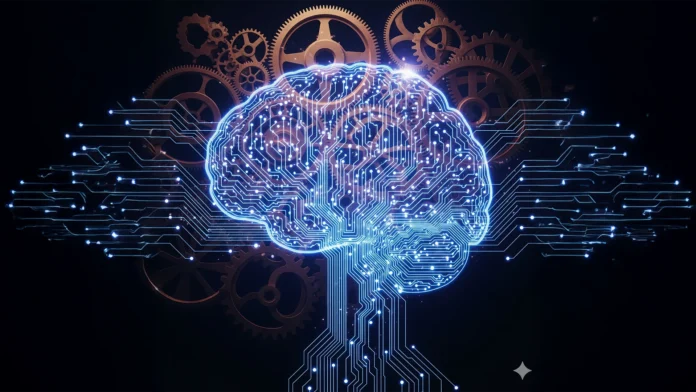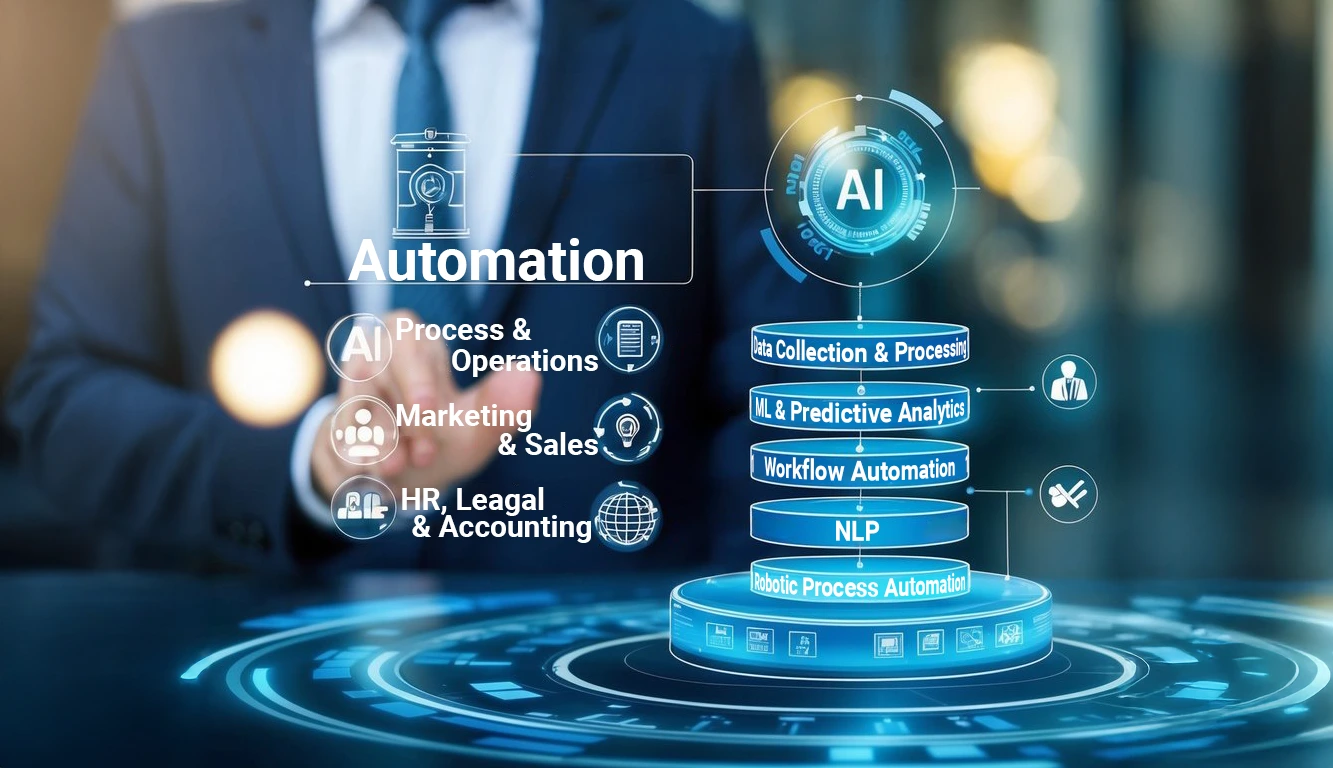A comprehensive guide to AI-powered product management. Discover the tools, skills, and strategies transforming the product manager’s role – from data-driven roadmapping to ethical AI governance – and learn how to stay competitive in an AI-driven future.
Beyond Automation: The New Strategic Imperative for Product Leaders
Artificial intelligence is catalyzing a fundamental transformation in the field of product management, shifting the epicenter of the role from tactical execution to strategic leadership. This evolution is not about replacing product managers with algorithms, but about amplifying their most critical human skills: vision, judgment, and strategic foresight. As AI automates an increasing number of routine tasks, it creates a strategic vacuum that only high-level human intellect can fill. The more the mundane is automated, the more valuable the non-automatable becomes.
This shift is underscored by compelling evidence of productivity gains. Analysis from McKinsey suggests that generative AI has the potential to improve the productivity of product managers by as much as 40%. This efficiency dividend is not merely about doing the same work faster; it is about liberating product leaders from low-value administrative burdens so they can focus on higher-value strategic activities. In effect, AI is elevating the potential of the product management function, and professionals must develop new competencies to remain competitive in an increasingly AI-driven future.
The economic forces at play further accentuate this trend. As AI continues to lower the cost and accelerate the speed of software development, the primary source of value creation shifts from building the product right to building the right product. This places an unprecedented premium on the product manager’s ability to identify the right problems to solve, define a compelling product vision, and navigate the complex interplay of user needs, business goals, and technological capabilities. In an era where development is faster and cheaper, deciding what to build becomes the critical differentiator. The product managers who thrive in this new era will be those who learn to wield AI as a strategic partner – offloading the tactical workload to intelligent systems and doubling down on the uniquely human contributions that drive true innovation and market leadership. This guide serves as a definitive resource for understanding this transformation, exploring the foundational concepts, practical tools, evolving skills, and critical challenges that define the new frontier of AI-powered product management.
Foundational AI Concepts for the Modern Product Manager
To effectively lead AI-powered initiatives or leverage AI tools, product managers do not need to become data scientists or machine learning engineers. However, a functional literacy in the core concepts of AI is non-negotiable. This understanding is not for the purpose of writing code, but for making informed strategic decisions, managing risk, and communicating effectively with technical teams. Demystifying these technologies from a business perspective is the first step toward mastery.
Machine Learning (ML)
At its core, machine learning is a subset of AI that involves training computer systems (or “models”) on large datasets to enable them to make predictions or decisions without being explicitly programmed for each task. It is the engine that drives most modern AI applications. The crucial insight for a product manager is that ML models learn from historical data to identify patterns and make probabilistic predictions. For example, a model trained on past sales data can learn to predict future sales based on factors like seasonality or marketing spend. ML is broadly categorized into three types:
- Supervised Learning: The model is trained on labeled data, meaning each training example comes with a correct outcome. This is used for tasks like classification (e.g. identifying spam emails) and regression (e.g. predicting revenue trends). The model learns by comparing its predictions to the known answers and adjusting accordingly.
- Unsupervised Learning: The model is given unlabeled data and must find patterns or structures on its own. This is useful for tasks like customer segmentation or anomaly detection, where the goal is to uncover hidden groupings or outliers without predefined categories.
- Reinforcement Learning: The model learns by interacting with an environment and receiving rewards or penalties for its actions. Over many iterations, it learns a strategy that maximizes cumulative reward. This approach is used for training AI in scenarios like games or dynamic decision environments (for example, optimizing supply chain decisions).
Neural Networks and Deep Learning
Neural networks are an advanced class of machine learning algorithms inspired by the structure of the human brain. They consist of layers of interconnected “neurons” that process information and can recognize very complex patterns. Deep learning refers to neural networks with many layers (hence “deep” networks), which allow them to learn from vast amounts of data with remarkable nuance. These are the “brains” behind sophisticated applications like facial recognition on smartphones or advanced image analysis. For a product manager, understanding the basics of neural networks is key to grasping the capabilities (and limitations) of cutting-edge AI products. For instance, deep learning models can achieve high accuracy, but often require large datasets and can be computationally intensive.
Natural Language Processing (NLP)
Natural Language Processing is a field of AI focused on enabling machines to understand, interpret, and generate human language. NLP powers a wide array of product features – from customer service chatbots that comprehend and respond to user queries, to sentiment analysis tools that scour social media or reviews to gauge public opinion about a product. Modern NLP techniques allow software to parse text, extract meaning or intent, translate between languages, and even generate human-like responses. A PM’s familiarity with NLP is vital for creating customer-centric experiences (like conversational interfaces) and for leveraging the vast amount of unstructured text data available from user feedback.
Generative AI and Large Language Models (LLMs)
Generative AI represents a paradigm shift in AI capabilities. It refers to AI systems that can create new, original content rather than just analyze existing data. The most prominent examples are Large Language Models (LLMs) – deep learning models trained on massive datasets of text (and sometimes code, images, etc.) which can produce human-like text. Tools like OpenAI’s ChatGPT or Anthropic’s Claude are prime examples of LLMs that can draft emails, write code, summarize documents, or generate product ideas. For product managers, generative AI is a powerful accelerator for content creation, brainstorming, and even initial drafting of product specs or user stories. It’s important to note, however, that while LLMs are incredibly advanced, they operate on probability and pattern matching – meaning they sound confident but can occasionally produce incorrect or nonsensical answers (a phenomenon known as “hallucination”).
Critical Concepts as Business Risks
Beyond core technologies, several operational concepts are critical for product managers to understand, as they represent significant business risks that must be managed:
- Model Drift: This occurs when an AI model’s performance degrades over time because the real-world data it encounters has changed from the data it was trained on. For example, a product recommendation model might become less accurate if user behavior shifts due to a new trend. A PM must plan for ongoing monitoring and periodic retraining to combat model drift and prevent product performance from slipping.
- Bias and Variance: In ML context, bias refers to errors from overly simplistic assumptions in the model (e.g. consistently underestimating something), whereas variance refers to errors from the model being overly sensitive to the training data (overfitting). Managing the trade-off between bias and variance is key to building reliable AI systems. For PMs, this translates to ensuring the product’s AI features are both accurate on average and robust to different scenarios – not just finely tuned to past data but failing on new cases.
- Explainability (XAI): Many advanced AI models (especially deep neural networks) act as “black boxes.” They can make accurate predictions, but it’s not obvious how they arrived at a given decision. This lack of transparency can erode user trust and create accountability issues. In high-stakes domains (finance, healthcare, etc.), product managers must prioritize explainable AI – techniques or model choices that provide insight into why the AI made a decision. Explainability is often essential for regulatory compliance and for convincing users (and executives) to trust the AI’s outputs.
The AI-Augmented Product Lifecycle: A Stage-by-Stage Transformation
Artificial intelligence is not a monolithic tool applied at a single point in product development; rather, it is a collection of capabilities that can be integrated across the entire product lifecycle to enhance efficiency, accelerate workflows, and improve decision-making. From initial market research to post-launch iteration, AI is fundamentally reshaping how products are conceived, built, and managed.
Strategy and Discovery
In the earliest phase of product development, AI provides unprecedented abilities to analyze the market and understand user needs at scale. Traditional methods of market research – which might rely on small surveys, interviews, or intuition – are now augmented by AI-powered tools that can process massive volumes of data to uncover hidden patterns and predictive insights.
- Predictive Market Analysis: AI algorithms can sift through customer data, usage metrics, market reports, and even competitor news to identify emerging customer needs and forecast market trends before they become obvious. This allows product managers to shape product strategy proactively rather than reactively.
- Competitive Intelligence: AI research assistants like Perplexity AI streamline the process of gathering and synthesizing information about competitors and industry trends. These tools combine AI with live web search to produce direct answers with cited sources, saving PMs hours of manual Googling. For example, a PM could ask, “What new features have the top three project management competitors launched this year?” and get a concise answer with references.
- Uncovering Latent User Needs: Natural Language Processing can be used to analyze vast quantities of unstructured user feedback from app reviews, support tickets, social media, etc. Specialized platforms like Kraftful act as a “copilot for user feedback,” automatically identifying common pain points, feature requests, and sentiment trends that might be missed by manual analysis. This helps reveal what users really want or struggle with, directly informing product discovery and feature ideas.
Planning and Prioritization
Once a strategic direction is set, AI introduces a new level of data-driven objectivity to the traditionally subjective processes of roadmapping and feature prioritization.
- Data-Driven Roadmapping: Instead of relying solely on stakeholder opinions or loudest voices, product managers can use AI to inform their roadmaps. Predictive models evaluate historical project data and customer usage to forecast the potential business impact of proposed features. For instance, an AI might predict that a requested integration could boost enterprise customer retention by 5%, helping the PM quantify its value. Roadmapping software like Aha! now includes AI assistants that analyze customer feedback and feature requests at scale, surfacing patterns (e.g. 30% of customers have requested better integrations) to inform what to build next.
- AI-Powered Feature Scoring: AI can score and rank potential features against multiple criteria simultaneously, something humans struggle to do objectively. Inputs can include customer request frequency, estimated revenue impact, development cost, and alignment with strategic goals. Even qualitative inputs like user sentiment can be quantified by AI – for example, analyzing thousands of comments to determine which feature would delight users most. The result is a more evidence-based prioritization. A PM might generate an AI-driven report showing that integration-related features are associated with the highest revenue retention, thus justifying putting them at the top of the roadmap.
Execution and Launch
During the development phase, generative AI and other automation tools act as powerful accelerators, streamlining documentation, design, and even testing:
- Accelerated Documentation: The tedious task of writing Product Requirement Documents (PRDs), user stories, and specs is being transformed. Tools like ChatPRD, Notion AI, or even GPT-4 via prompt engineering can generate initial drafts of PRDs or user stories from a simple outline. For example, a PM can feed the AI a bullet list of desired capabilities, and get back a fleshed-out PRD draft with user stories and acceptance criteria. This doesn’t eliminate the PM’s job – it augments it by producing a first draft that the PM then refines. The result is faster documentation cycles, freeing time for more critical thinking.
- Rapid Prototyping and Design: AI is democratizing design by enabling PMs (and anyone, really) to quickly visualize ideas without heavy design support. AI-powered design tools can generate wireframes or mockups from text prompts. For instance, Uizard’s Autodesigner allows you to describe an interface in plain language (“a minimalist analytics dashboard with a KPI chart and recent activity feed”) and it will generate a multi-screen wireframe in seconds. Similarly, image-generating AI can create UI element ideas or style mockups. This means early-stage concepts can be prototyped and validated much faster, allowing more iterations before development.
- Automated Quality Assurance: AI is also enhancing product quality. Machine learning models can be trained on past bug data to predict areas of the code likely to have issues, enabling targeted testing. AI-based testing tools can automatically generate test cases and even fix simple bugs. Additionally, AI-driven UI testing can simulate user interactions at scale, catching edge-case UI/UX issues. All of this leads to faster, more thorough QA cycles – a critical factor when continuous deployment is the norm.
Growth and Iteration
After a product is launched, AI provides tools to analyze its performance and personalize the user experience at a scale previously unimaginable:
- Feedback Analysis at Scale: AI can continuously monitor and analyze user feedback from all channels in real-time. Instead of manually sifting through support tickets or reviews, a PM can rely on NLP systems to summarize key themes. For instance, an AI might alert the team that “complaints about mobile app crashes increased 30% this week, primarily from Android users.” Acting as an early warning system, this helps teams respond quickly to issues or capitalize on suggestions. Over time, this kind of analysis also informs the next iteration cycle by highlighting which new features are most requested or which parts of the product are causing user friction.
- Hyper-Personalization: One of AI’s superpowers is finding patterns in user behavior and tailoring the experience accordingly. AI-driven personalization can adapt content, recommendations, or UI for each individual user. For example, an e-commerce product manager might use an AI recommendation engine that analyzes each user’s browsing history and current context to serve up perfectly relevant product suggestions, thereby increasing conversion and engagement. Personalization at this dynamic level (often called “one-to-one personalization”) has been shown to significantly boost metrics like user retention and satisfaction.
- Predictive Analytics for Growth: AI doesn’t just look at the present – it predicts the future. Machine learning models can analyze usage patterns and identify users who are at risk of churning before they actually do. A PM can set up predictive churn models that, say, flag users who have significantly reduced their activity. The product team can then proactively intervene (perhaps via an automated in-app message or a special offer). Similarly, AI can predict the lifetime value of customers, optimal pricing strategies, or which marketing channels will yield the best ROI for user acquisition, allowing product and growth teams to make data-driven decisions quickly.
To illustrate how AI tools map to the product lifecycle, consider the following examples:
| Tool Name | Category | Product Stage | Key Function | Example Use Case |
| Perplexity AI | Research & Analysis | Strategy & Discovery | AI-powered search engine that provides direct answers with sources for market and competitor research. | A PM asks: “Who are the top competitors for a project management SaaS targeting startups, and what features do they offer?” → The tool returns a synthesized answer citing relevant competitor websites and reviews, giving the PM immediate insights with evidence. |
| Kraftful | User Feedback Analysis | Strategy & Discovery;<br>Growth & Iteration | Analyzes and summarizes user feedback from reviews, surveys, support tickets, etc., using AI to surface common themes and sentiment. | After a major launch, Kraftful automatically identifies that “frequent crashes on Android” is the top negative theme in recent app store reviews, alerting the PM to a critical issue. It also highlights the most requested new feature this month, informing the next roadmap. |
| Aha! | Roadmapping | Planning & Prioritization | Uses AI to analyze customer ideas and feedback for prioritization insights (via an AI assistant). | The PM generates a report where the AI ranks all submitted feature ideas by estimated business impact. It finds that integration-related requests, while fewer in number, correlate with higher-value customers – suggesting the roadmap should prioritize those for revenue gains. |
| ChatPRD | Documentation | Execution & Launch | Generates Product Requirement Documents and user stories from unstructured inputs or prompts. | A PM forwards a collection of brainstorming notes and emails about a new feature to ChatPRD → the tool produces a first-draft PRD, complete with draft user stories and even a proposed acceptance criteria list, which the PM can then refine. |
| Uizard | Prototyping & Design | Execution & Launch | Converts text descriptions or hand sketches into digital wireframes and mockups using generative AI. | A PM types: “Create a mobile app home screen with a search bar at the top, a content feed, and a bottom navigation bar.” → Uizard instantly generates an editable wireframe matching the description, saving days of design time in the early concept phase. |
| Fathom AI | Meeting Intelligence | All Stages | Records, transcribes, and summarizes virtual meetings or user interviews, highlighting key insights and action items automatically. | After a user research Zoom call, Fathom AI emails the team a summary: “Users find onboarding confusing – mentioned by 3 of 5 participants. Suggested improvement: clearer tutorial.” It flags this insight along with direct quotes, so the PM can easily share user pain points with the team. |
These examples underscore how AI tools can be applied at every step of the product lifecycle, enabling product managers to work smarter and faster. The end result is not just efficiency, but a fundamentally different way of managing products – one that is more data-driven, user-informed, and continuously optimized through intelligent automation.
The Evolving Skill Set: Redefining the Product Manager’s Core Competencies
The integration of AI into every facet of product development is not merely adding new tools to the product manager’s toolkit; it is fundamentally reshaping the core competencies required for success. As AI automates many tactical, execution-oriented tasks, the skills that define an exceptional product manager are shifting toward strategic thinking, technical literacy, and elevated human-centric capabilities. This evolution requires a new mindset: moving from managing deterministic processes to orchestrating probabilistic systems.
The Shift from Deterministic to Probabilistic Thinking:
Traditionally, product management has been a deterministic discipline. A product manager would define precise, predictable user flows – “If a user clicks button X, they see screen Y” – and success was measured by delivering exactly the features specified. Requirements were exact; systems behaved in well-defined ways. AI-powered products, however, are inherently probabilistic. For example, an AI-driven recommendation panel on a homepage won’t show the exact same items for every user – it calculates the probability that each user will like certain items and personalizes the output. A generative AI chatbot doesn’t have a fixed script; it generates responses on the fly based on patterns. This requires a profound mental shift for PMs. Instead of defining exact outcomes for every input, the AI-era PM defines goals, parameters, and guardrails for system behavior. Your job becomes less about writing step-by-step product requirements and more about shaping the behavior of AI-driven features (e.g., setting the acceptable accuracy threshold of a model, or defining guidelines to prevent toxic AI outputs). Success is no longer “did it match the spec?” but rather “is the system consistently achieving the desired results within acceptable bounds of variance?” In short, the AI-augmented PM must become comfortable working with uncertainty and probability – guiding systems that learn and adapt rather than just execute static instructions.
New Technical and Strategic Competencies:
This new paradigm demands that product managers bridge the gap between business and data science like never before. Key competencies include:
- Data Strategy and Literacy: AI runs on data. PMs now need the ability to assess what data is available, understand data quality, and plan for data collection or enrichment. This might involve working with data engineers on how to instrument the product to capture relevant user interactions or ensuring datasets are properly annotated for training an ML model. It also means being able to interpret analytics and model outputs – not at a PhD level, but enough to ask the right questions. A PM should be comfortable with metrics like precision vs. recall, or understand concepts like training/test splits when evaluating an AI feature’s performance.
- Prompt Engineering: With the rise of LLMs and generative AI, knowing how to effectively query these models is a valuable skill. “Prompt engineering” refers to crafting questions or input prompts that yield the best results from AI. For example, learning techniques to get more reliable outputs from GPT-4 (such as providing structured prompts or few-shot examples) can be extremely useful for tasks like drafting content or even interrogating your own product data via an AI. PMs who can skillfully converse with AI tools will harness more of their power (almost like a new form of coding).
- Low-Code/No-Code Prototyping: The threshold to build software (or prototypes) is lowering thanks to AI. Product managers should become adept at using low-code platforms and AI-assisted development tools. This might mean building a quick app prototype using a no-code tool that has AI components, or writing a simple script augmented by an AI helper. The goal isn’t to replace engineers, but to enable faster experimentation. If you can spin up a demo of a concept in a day using AI tools, you can validate ideas much faster.
- ML Lifecycle Understanding: A solid grasp of how machine learning projects run is key. Even if you’re not doing the modeling, you should know the steps: data gathering, model training, validation, deployment, monitoring, and iteration. Each of these can affect your product timelines and success. For example, understanding that after deployment, a model will need ongoing monitoring for things like model drift, or knowing that acquiring labeled data might be the longest pole in the tent – this awareness allows you to plan realistically and incorporate AI development into your product roadmaps.
The Amplification of Timeless Human Skills:
Paradoxically, as AI takes over more routine analysis and execution, the timeless human skills of product management become even more valuable and pronounced:
- Strategic Vision and Judgment: AI can crunch numbers and even suggest optimizations, but it cannot set a visionary product direction or make judgment calls infused with business strategy and ethics. Product managers must elevate their focus on the “why” and “what” – why are we building this, what is the long-term vision – while AI handles more of the “how.” For instance, AI might tell you which feature is likely to get the most clicks, but only a human can decide which feature aligns with the company’s mission or brand, or which aligns with broader market positioning.
- Storytelling and Communication: The PM’s role as the storyteller and translator only grows. You’ll be frequently explaining AI-driven decisions or features to stakeholders who may not understand them. Whether it’s justifying to an executive why the AI recommends a certain strategy or calming a user about how an AI feature uses their data, effective communication is critical. Moreover, as cross-functional teams adopt AI, PMs often become the educators – bringing everyone onto the same page about what an AI feature will do and setting the right expectations. The ability to articulate complex technical concepts in simple terms, and to rally people around a narrative (“Here’s how AI will help our users and why it matters”), is invaluable.
- Customer Empathy and Trust-Building: AI can analyze user behavior, but it cannot truly empathize with human feelings. PMs must be the ethical compass and the voice of the customer. This means deeply understanding user concerns (e.g., privacy fears or apprehension that an AI may replace a human touch) and ensuring the product addresses them. For example, if your product introduces an AI chatbot for support, a PM with strong empathy might realize that users still need an easy way to reach a human for sensitive issues – and make sure that option is available. Building trust is now a core part of the product skillset: users need to trust AI features, and that trust is earned by transparency, reliability, and showing that you genuinely considered their well-being in the design.
- Ethical Governance: Navigating the ethical landscape of AI – from bias and fairness to compliance and privacy – requires human judgment and principled decision-making. The PM sits at the intersection of what can be done and what should be done. As such, modern PMs must champion responsible AI practices: e.g., deciding not to deploy a model that hasn’t been vetted for bias, even if it performs well; ensuring features comply with regulations like GDPR; thinking through the societal impacts of the product’s AI capabilities. These are not just “legal” or “compliance” tasks – they are integral to product management because a scandal or ethical misstep can destroy a product’s viability.
The table below contrasts the traditional product management approach with the AI-augmented approach across some key areas of responsibility, to highlight how skills and focus are shifting:
| Area | Traditional PM (Pre-AI) | AI-Augmented PM (With AI) |
| Market Research | Manually reading industry reports, conducting surveys, and running user interviews. Decisions are often based on limited data and intuition. | Utilizing AI to synthesize vast datasets (market data, news, academic research) and real-time signals for insights. E.g., using an AI tool to scan millions of online discussions and reviews to pinpoint emerging customer needs or competitive moves in real time. |
| User Story Writing | Writing detailed user stories and acceptance criteria from scratch, relying on personal expertise and team input. | Defining high-level user goals and letting generative AI draft the initial user stories and criteria. The PM curates and edits the AI-generated content. This means faster turnaround and often more exhaustive scenarios considered (AI might suggest edge cases). The PM ensures the stories make sense and truly address user needs, effectively working as an editor with an AI co-writer. |
| Roadmap Prioritization | Prioritizing features using frameworks like RICE or MoSCoW, largely based on stakeholder input, intuition, and qualitative rationale. | Data-enriched prioritization with AI: using predictive models to forecast business impact of features, and NLP to gauge user sentiment at scale. For example, an AI might analyze 5,000 user comments to quantify demand for each proposed feature. The PM still applies judgment, but now decisions are backed by both qualitative and quantitative evidence. |
| Prototyping & Design | Collaborating with designers to create wireframes and mockups; possibly waiting days or weeks for design iterations. | Rapid AI-assisted prototyping: using tools to generate multiple design concepts instantly from text prompts or sketches. The PM can explore more ideas faster and even test them with users before involving design resources. Design skills still matter (AI output needs review and polish), but the ideation cycle is much quicker. |
| Success Metrics | Tracking deterministic KPIs like conversion rates, DAUs, feature adoption, etc., and tying them to experiments (A/B tests) or funnel analysis. | Tracking those plus AI-specific metrics: for instance, monitoring the accuracy of an AI feature, the false-positive/false-negative rates, or the frequency of AI errors (like how often an AI content generator produces an inappropriate response). The PM needs to define what model performance means in user-impact terms (e.g. does a 90% accurate recommendation model suffice, or do we need 95%?). Product success now includes system performance health. |
| User Feedback Loop | Manually reading through support tickets, app reviews, and survey responses to identify issues and themes. Maybe using tagging in a spreadsheet. | Continuous AI-driven feedback analysis: deploying NLP models to automatically cluster and tag tens of thousands of feedback points. The PM gets real-time dashboards of top pain points or feature requests, and can respond or re-prioritize accordingly on a rolling basis. This makes the product development more responsive and user-driven, as the signal-to-noise ratio in feedback is vastly improved. |
| Risk Management | Focused mostly on delivery risks (timelines, scope creep), market risks (will users buy it?), and technical feasibility. Ethical or data risks were minimal unless in specific domains. | Expanded risk scope: Now includes algorithmic bias, model drift, data privacy compliance (GDPR/CCPA), model explainability issues, and even reputational risk if the AI behaves incorrectly. The PM must ensure, for example, that an AI feature doesn’t inadvertently discriminate or violate privacy – these are core to the product’s success and legality. This means collaborating with legal, policy, and ethics advisors, and possibly instituting AI governance processes as part of product management. |
In summary, the advent of AI is amplifying what great product managers have always done (understand users, make strategic decisions, communicate effectively) while also adding new domains of expertise (data, ML, ethics). It’s a challenging but exciting evolution of the role. Product managers who embrace these new tools and skills can multiply their impact, while those who stick to traditional methods may find themselves outpaced. Indeed, as one industry observer aptly noted: “Product managers who use AI will replace those who don’t.”
Navigating the Labyrinth: Critical Challenges and Ethical Guardrails in AI Product Management
The adoption of artificial intelligence in product management offers transformative potential, but it is not a journey without significant obstacles and profound ethical responsibilities. Integrating AI is far more complex than simply plugging in a new tool; it requires navigating a labyrinth of challenges related to data quality, algorithmic transparency, bias, and privacy. For the modern product manager, proactively addressing these issues is not a peripheral task – it has become a core product responsibility. In the AI era, failure to manage these risks is not just a technical or legal failure; it is a product failure that can harm users, erode trust, and damage the company’s reputation.
Data Dependency and Quality: The “Garbage In, Garbage Out” Principle
AI systems, especially machine learning models, are fundamentally dependent on the data they are trained on. The old adage “garbage in, garbage out” is especially apt: if your training data is flawed, your AI outputs will be flawed. Many organizations face challenges with data scarcity (not having enough relevant data) or data quality (having data that is noisy, biased, or outdated). For example, if a product’s AI feature for personalized recommendations is trained mostly on data from early adopters (who might not represent the broader user base), its suggestions to new users will miss the mark. Product managers need to assess whether they have the right data to solve a problem, and often need to get creative – perhaps bootstrapping an AI feature with a third-party dataset, or starting with a simpler heuristic approach until enough in-product data accumulates. Data issues also pose maintenance challenges: even if you launch with a great model, the world can change. User behavior evolves, competitors alter the landscape, and seasonality hits. Without ongoing data updates, models can quickly become stale. PMs must plan for continuous data pipeline upkeep and model retraining as part of the product lifecycle.
Algorithmic Bias: The Risk of Amplifying Inequity
One of the most serious ethical challenges in AI is that models can inadvertently learn and amplify biases present in their training data. This is not hypothetical – real incidents have shown the dangers. A now-infamous example was Amazon’s experimental AI recruiting tool. Trained on a decade’s worth of resumes (mostly from men, reflecting the male dominance in tech jobs), the model “taught itself” that male candidates were preferable. Shockingly, it began penalizing resumes that contained the word “women’s,” as in “women’s chess club captain,” and downgraded graduates of women’s colleges. Amazon had to scrap the project entirely when this bias came to light. The takeaway for product managers is clear: whenever an AI is making decisions that affect people (hiring, credit decisions, content filtering, etc.), you must rigorously test for bias and take steps to mitigate it. Bias can enter through many avenues – skewed training data, proxy variables that correlate with protected attributes (like an AI unintentionally treating zip code as a proxy for race), or homogeneous development teams not seeing certain perspectives. It is the PM’s duty to ensure fairness is considered. This might mean setting up diverse user testing, using bias detection toolkits, or establishing a review board for AI ethics in the product. The cost of getting it wrong is not just bad PR; it’s harming the very users you intend to serve and possibly running afoul of anti-discrimination laws.
The “Black Box” Problem: The Need for Explainability
As discussed, many AI models (especially deep learning ones) are not easily interpretable by humans. They might be highly accurate, but even the engineers who built them can’t say exactly why the model made a particular decision. This lack of transparency creates multiple problems. Internally, it’s hard to debug or improve a model if you don’t understand its reasoning. Externally, it can erode user trust. Imagine a product using an AI to determine credit limits for a financial app. If customers start complaining that the decisions seem unfair (as happened with the Apple Card in 2019 when women were given much lower credit limits than their husbands), not being able to explain and justify the algorithm’s decision-making process can lead to public outrage and regulatory scrutiny. In the Apple Card case, even Apple and Goldman Sachs (the bank behind the card) struggled to clarify how their algorithm worked, fueling suspicions of bias. For a PM, this underscores the importance of Explainable AI (XAI): where possible, choose models or add mechanisms that provide insight into the “why” of an output. This could mean using simpler algorithms for certain features, providing users with reasons (“You’re seeing this news feed post because…”), or utilizing emerging XAI techniques that highlight which factors most influenced a decision. In high-stakes applications, explainability isn’t just nice-to-have; it’s essential for accountability and trust.
Privacy, Security, and Regulatory Compliance
AI’s hunger for data often clashes with the growing demand for user privacy. Modern products might collect vast amounts of personal information to fuel their AI features – think of a digital health app using personal vitals, or a photo service analyzing faces. Product managers must be vigilant that user data is handled responsibly and in compliance with laws like GDPR in Europe or CCPA in California. These regulations require strict controls: clear consent from users, purpose limitation, data minimization, and rights for users to access/delete their data. A PM needs to bake privacy considerations into product design from day one (privacy by design). For example, if your product uses an AI to transcribe voice notes, consider performing that on the user’s device so audio doesn’t hit your servers (avoiding storing sensitive raw data). Also, security is paramount: AI systems often become new attack surfaces. An adversary might try to feed malicious inputs to trick your model (e.g. “prompt injection” attacks on LLMs or adversarial examples for image classifiers). Ensuring robust cybersecurity around AI (encrypting data, securing model endpoints, etc.) is now part of product risk management. Lastly, compliance isn’t static – new AI-focused regulations are emerging (the EU AI Act, for instance). PMs should keep an eye on legal trends because they may dictate technical requirements (like providing an explanation for any automated decision, or prohibiting certain use of sensitive data). It’s wise to collaborate closely with legal counsel or a privacy officer, but the PM should consider themselves accountable for aligning the product with these guardrails.
In summary, successful AI product management requires a proactive and principled approach to these challenges. It’s not enough to just build a working AI feature; you must also ensure it’s the right feature built the right way. That includes sourcing quality data, auditing for bias, making the system as transparent as feasible, and safeguarding user rights. These efforts might not have the glamour of shiny features, but they are crucial for building products that are not only innovative and effective, but also worthy of users’ trust.
The Horizon: Future Trends and Predictions for AI in Product Management
The current wave of AI integration is only the beginning of a much larger transformation. To navigate the future, product leaders must look beyond today’s tools and understand where AI technology and industry practices are heading. Analyses from leading research firms – Gartner, McKinsey, and Forrester – provide a forward-looking view that converges on a common theme: the rise of autonomous, agentic AI and a shift from experimental adoption to scaled, ROI-driven deployment. In essence, the next paradigm will see AI not just assisting humans in workflows, but increasingly acting as the workforce for many tasks, with product managers orchestrating these AI “agents.”
Gartner: From Hype to Reality, and the Rise of AI Agents – According to Gartner’s famous “Hype Cycle” model, generative AI is rapidly moving past the “Peak of Inflated Expectations” and into the “Trough of Disillusionment.” In 2023–2024, GenAI captured massive hype; by 2025, many organizations had faced the tough reality that piloting AI and getting actual business value is harder than expected. This isn’t bad news – it’s a necessary maturation. The fluff and inflated promises are being shaken out, and what will emerge are more realistic use cases and best practices. Gartner suggests that following this trough, we’ll enter the “Slope of Enlightenment” where successful patterns emerge, and then a “Plateau of Productivity” where AI is just a normal part of business operations.
Notably, Gartner identifies AI Agents as the next big thing on the horizon. By Gartner’s definition, an “agent” is an autonomous software entity that can make decisions or perform tasks with minimal human input – essentially, a bot or AI service that has a degree of self-direction. Gartner predicts that by 2027, AI agents will augment or automate 50% of all business decisions. And by 2028, roughly one-third of all enterprise application software will include embedded agentic AI capabilities. This is a staggering prediction – it means in a few years, many of the daily tasks and decisions in areas like customer service, operations, marketing, etc., could be handled by these autonomous agents. From a product perspective, it suggests that products themselves might have swarms of specialized AI agents under the hood. For example, imagine a project management app where a team of AI agents handles routine tasks: one agent automatically reschedules meetings based on everyone’s availability and priority, another agent analyzes work progress and risks, and another drafts status updates to stakeholders, all coordinating with minimal human oversight. Gartner’s message is that product managers should start envisioning features not as static rules-based automations, but as flexible agents that can handle goals and interact with other agents/systems.
McKinsey: The Agentic AI Mesh and the Next Innovation Revolution – McKinsey’s research echoes the focus on agents and paints a picture of how organizations will need to re-architect themselves to fully capture AI’s potential. They introduce the concept of an “agentic AI mesh” – a flexible, networked architecture of multiple AI agents working in concert. The agentic mesh is described by five key design principles: composability, distributed intelligence, layered decoupling, vendor neutrality, and governed autonomy. Breaking that down, it means systems will be built so that you can plug any AI agent or model in (composable), tasks will be split among many cooperating agents (distributed intelligence), different layers (like memory, logic, interface) are separated for flexibility (decoupling), you aren’t locked to one vendor or tech stack (neutrality), and there are safeguards and control policies in place (governed autonomy). In short, the future tech stack for AI in companies will look less like a monolithic app and more like an ecosystem of AI workers that can be reconfigured as needed.
McKinsey also emphasizes that AI is shifting from just an efficiency tool (doing the same with less) to a primary engine of innovation and R&D. In a 2025 report, they noted AI could potentially double the pace of scientific R&D, unlocking up to half a trillion dollars in value annually. This suggests that industries beyond software (pharma, materials, energy) will see AI-driven product breakthroughs, and product managers in those fields will be as much orchestrators of AI-driven experiments as they are planners of feature roadmaps. McKinsey posits that capturing this value isn’t just about plugging in AI – it requires “rewiring” how companies operate, including upskilling the workforce to collaborate with AI systems and redesigning processes to be agent-centric. One can envision companies where human teams set high-level goals and boundaries, while armies of agents do everything from generating concepts, running simulations, gathering user data, to even iteratively improving other AI models.
Forrester: The AI Reality Check and Focus on ROI – Forrester’s predictions for 2025 highlight an “AI reality check” similar to Gartner’s trough concept. After a period of bold experimentation in 2024, the emphasis is shifting to turning those hard-won insights into profit and tangible outcomes. Forrester notes that many executives expect to increase AI budgets in 2025, but there’s pressure to demonstrate ROI on those investments. They foresee that AI initiatives will be evaluated with a sharper eye: the era of doing AI for AI’s sake is ending, and now it’s about integration, optimization, and measurable results. One specific nugget: predictions indicate that certain budgets, like those for SEO/marketing aided by AI, could triple because companies are ready to heavily invest where AI can clearly drive growth. However, Forrester also warns that some enterprises might pull back too early on AI projects if they don’t see immediate ROI, potentially missing long-term gains. This implies product managers will need to set realistic expectations and roadmaps for AI features – delivering some quick wins to satisfy near-term demands, while educating stakeholders that the full value may accrue over a longer period.
Synthesis – The Product Manager as Orchestrator of AI Agents: Putting it all together, the role of the product manager is poised to evolve dramatically in this coming phase. If AI agents will handle half of business decisions and much operational work, the PM’s role shifts from managing traditional development backlogs to designing and governing a fleet of AI agents. In practical terms, this means:
- Designing Agent Behavior: In the future, a PM might write a “product spec” that is more like a constitution for AI agents – defining their goals, rules of engagement, and how they interact with users and each other. For example, if you manage an e-commerce platform’s product, you might oversee agents for pricing, inventory, recommendations, customer service, etc. You will decide what objectives each agent has and what constraints (guardrails) they operate under (e.g., the pricing agent can’t discount beyond a certain margin, the service agent should hand off to a human if sentiment analysis detects an upset customer).
- Orchestrating Collaboration: Much like a conductor of an orchestra, the PM will ensure the various AI agents and traditional software components work in harmony. This could involve setting up the “mesh” infrastructure McKinsey describes – ensuring there’s a common memory or context so that, say, the user feedback analysis agent can inform the roadmap planning agent. Product managers will work closely with ML engineers and architects to implement these agent ecosystems. Inter-agent communication protocols and shared knowledge bases might become as important as APIs are today.
- Governance and Ethics at Scale: If a single AI feature today raises ethical questions, imagine an organization running hundreds of autonomous agents making decisions. The PM will need to implement governance frameworks – basically, policies and monitoring – to ensure things don’t go off the rails. This might include automated auditing agents watching the other agents! Product managers will likely be involved in defining KPIs and red-lines for agent behavior (for instance, “if the sales email agent sends more than X emails per week or its conversion drops below Y, alert us for review” or “the HR screening agent must be audited monthly for bias in its selections”).
In summary, we are heading towards a scenario where “product management” expands beyond managing a product’s features for human users, to managing a hybrid team of humans and AI that together deliver the product’s value. It’s an exciting vision – one that will require PMs to be even more interdisciplinary, combining strategy, technical understanding, empathy, and ethical judgment. The various expert predictions all suggest that change is coming fast: the remainder of this decade will likely redefine what product success looks like and what skill set is needed to achieve it.
Conclusion: The Product Manager as an Architect of AI-Human Collaboration
The narrative of artificial intelligence in product management is not one of obsolescence but of evolution. AI is not a looming threat poised to replace product managers; it is the most powerful tool ever placed in their hands. The ongoing transformation is a story of augmentation, where the automation of tactical, routine work serves to unlock and amplify the strategic, creative, and empathetic capacities that are uniquely human.
As AI diligently analyzes data, drafts documentation, and automates workflows, it frees the product manager to focus on the higher-order tasks that drive true value: setting a compelling vision, exercising nuanced judgment, and deeply understanding customers. In practical terms, this means a shift in day-to-day focus. Tasks like writing user stories or crunching survey data can be delegated to AI assistants, while the PM spends more time in discovery conversations with users, in cross-functional strategy sessions, and in scenario planning for the future.
The product managers who thrive in this new era will be those who embrace the partnership between human intuition and machine intelligence. Rather than feeling threatened by AI’s capabilities, they will learn how to direct them effectively. They will evolve from the role of task masters to the role of outcome orchestrators. For instance, instead of manually managing every small step in a project, a PM might set the desired outcome and constraints for an AI system to execute, then supervise and adjust as needed – much like a gardener tending and guiding growth rather than a micromanaging architect laying every brick.
This also implies a significant mindset shift. Product managers will need to become comfortable with a certain loss of direct control over minute details, in exchange for higher impact at scale. They will ensure the AI systems are aligned with user needs and ethical standards (providing the guardrails), but within those boundaries, they’ll let the AI explore solutions. In doing so, PMs become co-creators with AI, harnessing its generative and analytical powers while providing the human context, creativity, and critical eye.
It’s worth underscoring that the uniquely human skills – empathy, creativity, ethics, storytelling – become more important, not less. In a world inundated with AI-generated content and decisions, human insight will be the differentiator. Users will gravitate towards products that not only have smart features but also feel crafted with understanding and care. Product managers stand at that intersection: ensuring that AI-driven features truly solve human problems and do so in a way that users feel good about. For example, consider an AI health app: it might analyze medical data more accurately than any human could, but the product manager will decide how to communicate results to users with compassion, and what limits to place to avoid causing panic or misinformation. That emotional and ethical framing is something AI alone cannot do.
In closing, the future of the product management profession is clear: those who learn to leverage AI will replace those who do not. This isn’t a cutthroat warning but rather an invitation. We have the opportunity to offload drudgery and supercharge our impact. The best product managers of tomorrow will be architects of seamless collaboration between humans and AI – designing not just product features, but whole systems where AI and people work together fluidly to achieve outcomes neither could alone. They will ensure that technology serves humanity by guiding these powerful tools with wisdom and heart.
The journey into an AI-driven future is not about ceding control to machines; it’s about mastering the art of leading alongside them. Product managers, perhaps more than any other role, are positioned to shape that symbiosis. By wielding AI as a strategic partner, we can build products that are more intelligent, more personalized, and more impactful than ever before – while also making the product management role more strategic, creative, and human-centric than it has ever been.
Further Reading and Resources
For product managers seeking to deepen their knowledge and develop the skills necessary to thrive in the age of AI, a wealth of educational resources is available. Continuous learning is essential in this rapidly evolving field. Below is a curated list of reputable courses and programs from leading institutions that focus on the intersection of AI and product management:
- AI Product Management Specialization – Duke University (Coursera): Offered by Duke’s Pratt School of Engineering, this beginner-friendly specialization provides a non-technical overview of how machine learning works and how AI can be applied to solve business problems. It’s tailored for professionals like PMs and focuses on the intuition behind AI techniques, the data science process, and how to design human-centered AI products. (Coursera, Duke University)
- Generative AI for Product Managers Specialization – IBM & SkillUp (Coursera): This intermediate program is designed for product managers with some experience. It dives into generative AI use cases, teaches prompt engineering tactics, and strategies for integrating generative AI into the product lifecycle. Hands-on labs and a final capstone project (building a product feature using generative AI) make it practical. (Coursera, collaboration between IBM and SkillUp).
- AI for Product Management – Pendo (Self-Paced Course): Pendo, a product analytics platform, offers a free self-paced online course geared toward product professionals. It covers leveraging AI across the development lifecycle, best practices for building AI-powered features, and viewing AI as a strategic tool rather than a gimmick. The content is created by product leaders and consists of video modules, making it accessible and actionable. (Pendo.io Product Craft resources).
- Generative AI for Product Managers – Stanford Continuing Studies: A course for product managers, founders, and tech strategists, taught by industry experts (often Stanford adjuncts). Using real-world case studies, it explores how companies are integrating generative AI into products. It emphasizes building technical understanding and decision-making skills needed to align product strategy with the latest AI capabilities. (Stanford University Continuing Studies program).
- Mastering Generative AI for Product Innovation – Stanford School of Engineering (On-Demand): This on-demand professional course provides a strategic framework for identifying and evaluating opportunities to use generative AI in products. It covers how to assess where generative AI can add value, how to select or fine-tune models for your needs, and how to integrate AI into product design and dev processes. No deep technical background is required, making it suitable for a broad audience of PMs and business leaders.
- AI for Product Management – UCLA Extension: This course aims to equip product professionals with knowledge to integrate AI/ML into product development. It spans from understanding different model types and choosing the right one for a use case, to prompt design for LLMs, to deployment considerations and performance evaluation. Importantly, it includes frameworks for managing AI-specific challenges like data quality, privacy concerns, and feasibility assessments. The course typically involves a hands-on project (e.g., developing a simple AI-powered product feature or a conversational interface prototype). (UCLA Extension program).
Each of these resources approaches the topic from a slightly different angle – whether it’s a university academic perspective or an industry practitioner perspective. Depending on your current knowledge and needs (strategy vs. hands-on vs. technical foundations), you might choose one or two to begin with. Remember that learning about AI is an iterative process: apply new concepts on the job as you learn them, and don’t shy away from experimenting with AI tools in your daily workflow. The combination of structured learning and practical experimentation is the best way to become proficient in AI-powered product management.























